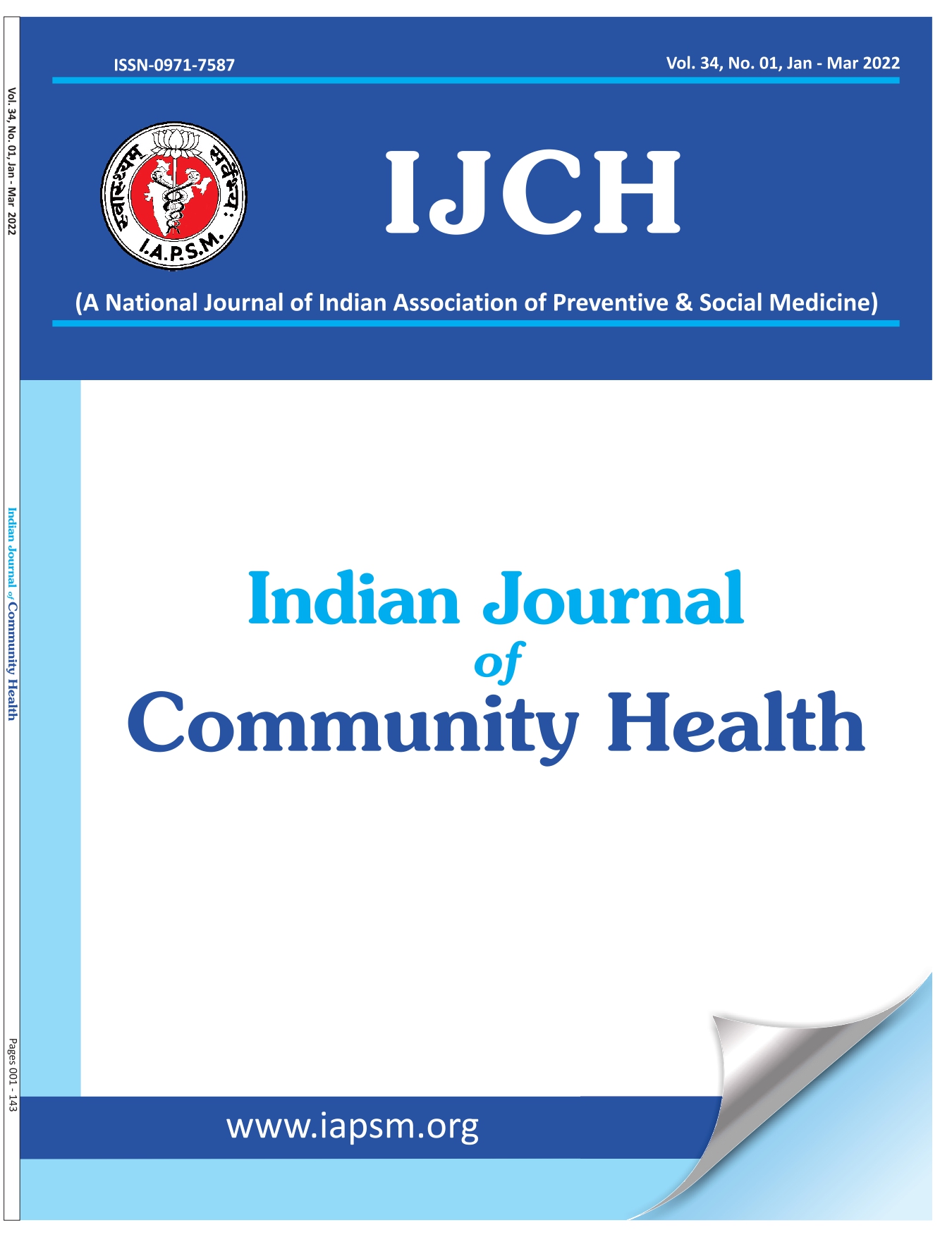Diarrhoeal diseases and its relation to WaSH practices and MPN count among under-five children residing in Resettlement colony, Delhi
DOI:
https://doi.org/10.47203/IJCH.2020.v32i03.009Keywords:
Diarrhoeal diseases; under 5, drinking water quality, presumptive coliform count, WaSH practicesAbstract
Background: Globally, diarrhoeal diseases are the second leading cause of death among under 5 children and India alone accounts for 100,000 lives annually, third highest in the world. In low and middle-income countries, contaminated water has been the major source of diarrhoeal diseases and lack of improper WaSH (Water, Sanitation and Hygiene) practices accounts for 90% of the total death. Aims and Objective: To find out the burden of diarrhoea and its relation to WASH practices among children and mothers/care givers and Presumptive Coliform count of drinking water. Materials and Methods: A community-based cross-sectional study conducted in Resettlement colony, Delhi. A total of 553 under 5 children were studied after attaining consent from mothers/care givers. MPN count per 100 ml was measured from drinking water storage vessel. Result: Prevalence of diarrhoea was found to be 40.70%, being higher among children aged between 13-24 months (57.3%). Out of the total water samples, 37% of samples were unsatisfactory, 36% suspicious and 22% satisfactory. None of the samples were found to be satisfactory. Lack of WaSH practices was observed among mother/care givers. Conclusion: Understanding the factors influencing the occurrence of diarrhoeal diseases and drinking water quality will help reduce the burden of diarrhoeal diseases.
Downloads
References
World Health Organization. Diarrhoea. Available at: https://www.who.int/topics/diarrhoea/en. Accessed on 20 January 2020
World Health Organization. (2018). Diarrheal disease. Available at: http://www.who.int/newsroom/fact-sheets/detail/diarrheal-disease. Accessed on 20th January 2020.
National Family Health Survey (NFHS 4), (2015-2016). Available at: http://rchiips.org/NFHS/factsheet _NFHS-4.shtml. Accessed on 20th January 2020.
Basa S. Prevalence of Diarrhoea among Under-Five children and Health Seeking Behavior of their Mothers in an Urban Slum of Delhi. Asian Journal of Biomedical and Pharmaceutical Sciences. 2015 Jun 1;5(45):08.
WHO. Guidelines for drinking-water quality, 4th edition, incorporating the 1st addendum. Geneva: WHO; 2017
Kirk MD, Angulo FJ, Havelaar AH, Black RE. Diarrhoeal disease in children due to contaminated food. Bull World Health Organ. 2017 Mar 1;95(3):233-234. doi: 10.2471/BLT.16.173229. Epub 2016 Nov 25. PMID: 28250537; PMCID: PMC5328108.[PubMed].
Ashbolt, N. J., Grabow, W. O. K., & Snozzi, M. (2001). Indicators of microbial water quality. In L. Fewtrell & J. Bartram (Eds.), Water quality - guidelines, standards and health. Assessment of risk and risk management for water-related infectious disease. (pp. 289-316). https://www.dora.lib4ri.ch/eawag/islandora/object/eawag:11261
Kalakheti B, Panthee K, Jain K. Risk Factors of Diarrhea in Children Under Five Years in Urban Slums: An Epidemiological Study. JLMC [Internet]. 26Jan.2017 [cited 10Oct.2020];4(2):94-8. Available from: https://www.nepjol.info/index.php/JLMC/article/view/16473
Chilambwe M, Mulenga D, Siziya S. Diarrhoea Prevalence in Under-Five Children in Two Urban Populations Setting of Ndola, Zambia: An Assessment of Knowledge and Attitude at the Household Level. J Infect Dis Ther. 2015;3(227):2332-0877.
Faure F, Demars C, Wieser O, Kunz M, De Alencastro LF. Plastic pollution in Swiss surface waters: nature and concentrations, interaction with pollutants. Environmental Chemistry. 2015 Jan 1;12(5):582-91.
Adane M, Mengistie B, Medhin G, Kloos H, Mulat W. Piped water supply interruptions and acute diarrhea among under-five children in Addis Ababa slums, Ethiopia: A matched case-control study. PLoS One. 2017 Jul 19;12(7):e0181516. doi: 10.1371/journal.pone.0181516. PMID: 28723927; PMCID: PMC5517045.[PubMed].
Delhi Urban Slum Improvement Board. In situ development of Kalyanpuri skums, Delhi.
Sisodia MS, Kumar R, Pawaiya AS, Mishra S. A Cross Sectional Study of Socio-demographic Determinant of Diarrhea among Underfive Children of Rural Area of District-Hapur. Indian Journal of Public Health Research & Development. 2016 Apr 1;7(2).
Darvesh N, Das JK, Vaivada T, Gaffey MF, Rasanathan K, Bhutta ZA; Social Determinants of Health Study Team. Water, sanitation and hygiene interventions for acute childhood diarrhea: a systematic review to provide estimates for the Lives Saved Tool. BMC Public Health. 2017 Nov 7;17(Suppl 4):776. doi: 10.1186/s12889-017-4746-1. PMID: 29143638; PMCID: PMC5688426.[PubMed].
Agegnehu MD, Bewket Zeleke L, Goshu YA, Ortibo YL, Mehretie Adinew Y. Diarrhea Prevention Practice and Associated Factors among Caregivers of Under- Five Children in Enemay District, Northwest Ethiopia. J Environ Public Health. 2019 May 12;2019:5490716. doi: 10.1155/2019/5490716. PMID: 31214265; PMCID: PMC6535883.[PubMed].
Ercumen A, Naser AM, Unicomb L, Arnold BF, Colford JM Jr, Luby SP. Effects of source- versus household contamination of tubewell water on child diarrhea in rural Bangladesh: a randomized controlled trial. PLoS One. 2015 Mar 27;10(3):e0121907. doi: 10.1371/journal.pone.0121907. PMID: 25816342; PMCID: PMC4376788.[PubMed].
Downloads
Published
How to Cite
License
Copyright (c) 2020 Indian Journal of Community Health

This work is licensed under a Creative Commons Attribution-NonCommercial-NoDerivatives 4.0 International License.





